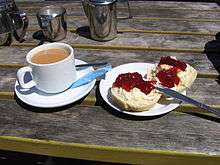Cream tea
 | |
| Alternative names | Devonshire tea, Cornish cream tea |
|---|---|
| Place of origin | England |
| Region or state | South West England |
| Serving temperature |
Tea: hot Scones: warm Jam & cream: ambient |
| Main ingredients | Tea, scones, clotted cream, strawberry jam |
| Variations | Multiple |
| High kcal | |
|
| |

A cream tea (also known as a Cornish cream tea or Devon cream tea )[1] is a form of afternoon tea light meal, consisting of tea taken with a combination of scones, clotted cream, and jam. Traditionally a speciality of Devon and Cornwall, cream teas are offered for sale in tea rooms in those two counties, as well as in other parts of England, and elsewhere in the Commonwealth.
History
The name "Devonshire tea" comes from the county of Devon in England. The exact origin of "cream tea" is disputed, although there is evidence to suggest that the tradition of eating bread with cream and jam already existed at Tavistock Abbey in Devon in the 11th century.[2] The earliest use of "cream tea" in the sense of this article (as opposed to a cup of tea with cream in it) that the OED can find is in 1964 "Picture of Millie" by Philip Maitland Hubbard which has; "We just bathe and moon about and eat cream teas." The "Foods of England" website has discovered a newspaper cutting, 'The Cornishman' of Thursday 3 September 1931 (p8), which uses the phrase in its modern sense. [3]
Variations
There are regional variations as to how a cream tea should preferably be eaten. The Devonshire (or Devon) method is to split the scone in two, cover each half with clotted cream, and then add strawberry jam on top. Traditionally it is important that the scones be warm (ideally, freshly baked), and that clotted (rather than whipped) cream and strawberry jam, rather than any other variety, are used. Butter is generally not included, and some sources advise that the tea should not be served with milk.[4] The Devon method is also commonly used in the neighbouring counties of Somerset, Hampshire, Dorset and the Isle of Wight.
In Cornwall, the cream tea was traditionally served with a "Cornish split", a type of slightly sweet white bread roll, rather than a scone.[5] It is now rare to find this available commercially, even in Cornwall, but splits are still used by many Cornish families in their own homes. The warm roll (or scone) is first buttered, then spread with strawberry jam, and finally topped with a spoonful of clotted cream. Scones are rarely buttered in commercially available teas. In Devon, an alternative to the scone found occasionally is the "Devon split" or "Chudleigh", lighter than a scone and smaller than a Cornish split.[6]
Although these distinctions are still claimed by many, cream teas are served and enjoyed both cream first and jam first throughout both counties.
Where clotted cream is not available, whipped cream is sometimes used as a substitute. Another variation to a cream tea is called "Thunder and Lightning", which consists of a round of bread, topped with clotted cream and golden syrup, honey, or treacle.[1]
Protected status
In May 2010, a campaign was launched at the Devon County Show to have the name "Devon cream tea" protected within the European Union under Protected Designation of Origin (PDO) rules. The campaign was launched following discussion on BBC Radio Devon.[7]
See also
References
- 1 2 Salmans, Sandra (5 September 1982). "BRITAIN'S BEST AT TEATIME". The New York Times. Retrieved 28 January 2007.
- ↑ "Were cream teas 'invented' in Tavistock?". BBC News. 17 January 2004. Retrieved 28 January 2007.
- ↑ http://www.foodsofengland.co.uk/creamtea.htm
- ↑ Not Panicking Ltd (20 October 2015). "h2g2 – Cream Teas – Edited Entry". bbc.co.uk.
- ↑ O'Brien, Harriet (8 July 2006). "Cornwall: a clean break". The Independent. London. Retrieved 28 January 2007.
- ↑ "Cornish Splits, some very exciting news and a thank-you", Regula Ysewijn, 16 April 2013. Retrieved 23 May 2017
- ↑ "Devon cream teas could get EU protected status". BBC News. 19 May 2010. Retrieved 6 January 2015.
Further reading
- Smillie, Susan (20 May 2010). "It's scone wrong". The Guardian. London. Retrieved 26 April 2011.
- Kirby, Terry (6 November 2009). "Jam or cream first? The great scone debate …". London Evening Standard. Retrieved 26 April 2011.
- "How do you take your cream tea?". BBC Radio Cornwall. 9 June 2010. Retrieved 26 April 2011.

